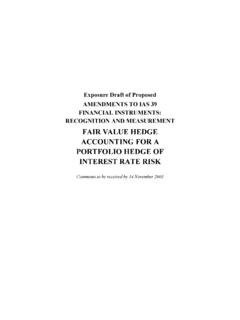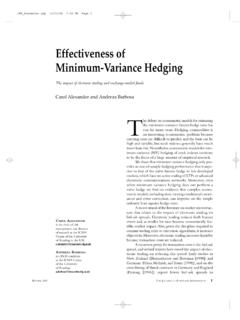Transcription of HOW TO CREATE GREEN LIVING SCREENS ... - Hill …
1 HOW TO CREATE GREEN LIVING SCREENS FOR. PRIVACY AND OTHER FUNCTIONS. LIVING SCREENS can enhance privacy, cover an unsightly garden area, and provide shade. They can mitigate noise and provide passive heating and cooling. They can offer habitat for bees, butterflies, hummingbirds, and other beneficial creatures who share your space. They can be used to CREATE alluring "outdoor rooms" within your own garden. They can even serve as a food source. Though it can be a challenge to find screening or hedging plants that can handle the hot dry climate and intense sun of central Texas, you do have many options for creating LIVING SCREENS , building GREEN Garden Walls, or establishing Separate Landscape Sections of your garden. The conventional landscaper's approach to creating a residential hedge is to identify one evergreen shrub and plant it continuously in a straight line. Modern landscapers recognize the weakness of this type of planting.
2 Besides being dull in appearance, it lacks healthy diversity. A single-species hedge creates an excellent opportunity for pests and plant disease: If one plant is diseased or pest-ridden, the problem will travel all the way down the hedge line. In building your hedge, therefore, we suggest you either: 1) choose multiple varieties of one species; or 2) choose multiple species. 1) One species, multiple varieties: A dominant species such as roses is a good choice. The rose species offers a number of evergreen and drought-tolerant varieties, and gives a rich range of bloom color over a long period. For your primary hedging element, try using hardy Old Garden Roses (defined by the American Rose Society as roses introduced before 1867). Use three to five varieties in a repetitive pattern. Over the past 30 years, several shrub roses have been bred from Old Garden Roses specifically for hedging purpose. Belinda's Dream, Grandma's Yellow, and Iceberg are three of the hardiest modern varieties.
3 These three work well in combination with one another or mixed with other Old Garden Roses such as Nearly Wild, Eutin, Prosperity, and Ducher. A rose hedge offers diverse colors, various heights, and a dense evergreen screen that supports bee and butterfly habitat. The depth and dimension enhance visual interest while improving the effectiveness of the screen . 2) Multiple species: When planting for diversity, try to use a minimum of three plants of each species you choose, and no more than seven of each species. You might find it helpful to think in terms of guilds (groups of plants that grow well together). Here's one example of a healthy screen Guild : Tall Focal Point: 'Natchez' Crape Myrtle (1). Medium Blooming Shrubs or Ornamental Trees: Species Mallows (3). Small Evergreen Shrubs: Salvia greggii x (5). The variety of species adds interest in the landscape across multiple seasons; gives fragrance to the garden; and creates bee, butterfly, and hummingbird habitat while providing a user-friendly solution for privacy.
4 For the best GREEN LIVING screen , plan for a 4' to 6' wide space. You need to consider the heights of any existing cables, phone lines, or electrical infrastructure. Small plants will grow large, and it can be very costly to remove or even trim unwanted foliage from electrical wiring. The mature size of any LIVING screen plants should be a primary determining factor in the height of the screen . Normal height for residential division is 6' to 8' which obscures most objects from the standard line-of-sight, but it might also be wise to check with any city regulations or subdivision covenants. Additional height may be needed for screening purposes as in the case of obscuring an old shed or building. The length of the screen should be determined by the length of the view to be blocked. Species Guide Medium Ornamental Shrubs and Trees Medium and Tall Trees Evergreen Shrubs 4-6' Almond Verbena 8-12' Arizona Cypress 2-4' Agave Hybrids 3-8' Aromatic Sumac 12-15' Basjoo Banana 3-5' Barbados Cherry 6-8' Brugmansia 8-16' Carolina Buckthorn 2-5' Blueberry - Lemonade 4-6' Ceanothus 15-25' Carolina Cherry Laurel 2-3' Cenizo, Silverleaf 4-8' Desert Sumac 15-20' Holly Leaf Cherry 2-4' Creosote Bush 4-8' Dwarf Olive 15-25' Holly/Ilex opaca 2-3' Desert Spoon, Sotol 3-4' Dwarf Pomegranate 15-25' Ilex Nellie R.
5 Stevens 2-4' Desert Yaupon 6-12' Elderberry 10-15' Mexican Elderberry 3-4' Doghobble 6-8' Ilex Steeds 20-30' Madrone 2-3' False Red Yucca 6-8' Jojoba 20-30' Natchez Crape Myrtle 2-3' False Yellow Yucca 8-10' Lady Palm 20-40' Olive 2-4' Gardenia 8-12' Lemon Bottlebrush 8-20' Pomegranate Frost-Proof or Veitchii 4-6' Madrone, Compacta 20-30' Robinia 2'x3' Ilex Soft Touch 3-8' Manzanita 20+' Rose Lady Banks 2-5' Kangaroo Paw 8-12' Mexican Buckeye 9-15' Rosewood 1-3' Manfreda Hybrids 8-12' Mountain Mahogany 20-30' Santa Rosa Plum 3-4' Manzanita 10-12 Orange Jassamine 12-25' Silverbell 2-4' Mexican Oregano 10-12' Purple Hop Seed Bush 15-20' Strawberry Guava 1-4' Rose Miniatures 4-6' Rose Belinda's Dream 10-20' Sweet Viburnum 3-4' Salvia Greggii 4-5' Rose Grandma's Yellow 12-20' Tea Olive 2-3' Thicket Wax Myrtle 2-4' Rose Iceberg 6-20' Texas Mountain Laurel 2-4' Yucca Hybrids 3-5' Rose Nearly Wild 15-20' Texas Wild Olive 12-15' Rusty Blackhaw 15-30' Texas Persimmon Viburnum 10-25' Texas Pistachio 4-6' (Ilex)
6 Schilling's Dwarf 10-20' Texas Redbud 8-12' Silk Tassel 15-30' Yaupon/ Ilex vomitoria 6-8' Sugar Bush Sumac 12-25' Wax Myrtle 5-8' TX Ranger, Cenizo 16-22' Wild Cherry 4-6' Texas Croton 4-8' Dwarf Wax Myrtle GREEN LIVING Barriers for Full Sun Ideally a GREEN LIVING Barrier for Full Sun requires a minimum of 6 hours of full sun. The timing does vary with the time of year, but it is best to always plant for the hottest, longest days of Texas August. Several landscaping techniques can easily be utilized to assist and reinforce the Full Sun LIVING Barrier Design in the residential landscape. Too often, this need is solved with planting native cactus in a wide stretch and then ignoring it. Minimal interest is added by placing a boulder or two. The result is a barrier, but an unfriendly and harsh barrier. Granted, this solution limits the need for yearly maintenance that involves weeding, trimming, and removal of diseased material.
7 But we can improve on it by introducing more diversity. Diverse plant material is always the best solution for a long-lived, attractive, and healthy planting of any kind. A GREEN LIVING Barrier can be created from multiple species that are hardy, drought-tolerant and well-adapted to Texas climate. Fortunately, there are multiple species and newly developed hybrids that can be planted. Diversity can also be created through careful selection of Specialty Arid Plants such as Agave, Manfreda, Hesperaloe and Yucca. Too often this solution creates a thorny and unfriendly barrier, but with careful selection of species, it can also be a hardy, drought-tolerant and attractive LIVING screen . Many of these new selections have highly attractive variegation, unique colors, and 'softer' leaves with minimal or no thorns or spikes. This is particularly true in the new agaves, manfredas, and multiple yuccas. Several of these yucca resemble grasses more than the traditional vision of spiny native yucca.
8 A positive solution for the environment, as well as appearance, is to select Multiple Species and use multiple members of that species in a natural design that copies nature. Another solution is utilize the advantages of Berm- Planting. Creating a berm can be a easy solution for clay soils. It can add as much as 4' of height to any design and enhances drainage for such Specialty Arid Plants. The berm can be sited over the hottest, sunniest portion of the full-sun dry-area planting, which is normally the western end if the barrier runs east to west. If the barrier runs north-south, position the berm on the western side. Another technique is to Interplant Deciduous and Evergreen plants. Taller, deciduous and blooming shrubs such as mallows, almond verbena, and sumac can be positioned in the center of the hedge and evergreen shrubs such as salvia greggii and Mexican oregano placed in front of the taller specimens to obscure the bases of the deciduous shrubs.
9 The same inter-planting concept can be used to CREATE a larger-scaled hedge by upsizing the selected species. For instance, substitute taller, deciduous blooming shrubs with taller, ornamental trees such as Redbud, Buckeye, or Desert Willow. Continuing the upgrade concept, place evergreen shrubs such as Dwarf Wax Myrtle or Dog Hobble at the base. GREEN LIVING SCREENS for Noise Abatement Planting a LIVING screen for Noise Abatement is defined as planting a combination of plants that can absorb noise or greatly reduce it. Most noise begins at the street level, but planting a long row of GREEN will do little to impact on street noise. Several landscape elements added to the design can enhance the noise absorption level. For instance, the addition of a 3' to 4' tall Berm or a 40% Slope can reflect the noise backward or deflect it upward. Other features such as retaining walls, 3' solid fencing features or large boulders placed into a natural slope design can assist in the deflection of pavement noise.
10 The closer these features are placed to the street or noise, the better. Research indicates that even the densest GREEN barrier will only minimize sound, but not eradicate it. A solution may be to consider Noise Competition not elimination. The installation of bubbling fountains, pools, waterfalls and small, rippling streams can not only soothe the senses, but minimize city noise. Landscapers recommend a comprehensive plan that includes combination of both plant material and distracting competition. One landscaper gives each of his clients a large wind chime when noise abatement is a landscape issue. GREEN LIVING SCREENS should be evergreen, moderate-growing, and plants that develop dense foliage. When possible, a double planting of evergreen material of 6' tall mature size or better can reduce street noise by as much as 40%. If a chain link or other open design of fencing is installed, consider planting on both sides of the fencing material.





